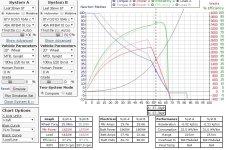Balmorhea said:
I feel like you're analogous to someone who has a horse, but who instead of riding it, goes to great length to design and build a complex and fragile mechanical capsule around the horse that will allow the horse's natural gallop to carry him at double the horse's natural speed.
I don't see how that analogy would apply considering I ride this vehicle every day. I have over 40,000 miles on it, with no motor. The current body shell, the 2nd one I have built, while not the most durable thing in the world, already has more than 4,000 miles on it placed on it during the last 6 months.
AND it is the fastest, most fun, and most practical bike I have ever owned. I can load 2 weeks worth of groceries in the trunk space. I don't have to worry about losing my balance and falling off, which on a normal diamondframe bike will usually mean hitting the pavement face first from a height of 6 feet. I have protection from the sun and rain. Car operators treat the vehicle with more respect than they would a normal bike because it looks like it would damage their car if they hit it, and it is also more visible. The body shell also does supply a rudimentary amount of collision protection, that even though it would not fare well against vehicles 15x the laden mass, it is preferable to a normal bike in this regard. Most importantly, as long as I'm not going up too steep of a hill, on most streets, I can maintain flow of traffic speeds in city conditions, given that cruising at almost 25 mph on flat ground is no problem for me, and I can reach 37 mph in an all-out sprint, which means there is a reduced speed differential between me and the auto traffic in most cases versus a normal bicycle or even most street legal e-bikes.
In fact, I've raced people on street legal e-bikes, you know, the ones you can buy that only make about 750W and top out at 20-28 mph, and had no problem leaving them behind the vast majority of the time. The only time I cannot keep up is on long climbs up hills of more than 10% gradient.
Here's a video of me pedaling it at 30-40 mph:
https://vimeo.com/284616898
https://vimeo.com/284616919
That body shell has since been removed and I have a more slippery one on the trike now. This second shell is also incomplete as I am trying to perfect some aluminum wheel farings for it as well as a bubble top and turtledeck. Just think of what an electric drive is going to do for it!
I mean, sure... I guess. But at what cost? And in the service of what?
My total build cost when this prototype is finished as an EV will be less than that of a decent mid-range road bike purchased new, and way less than a purpose-built triathlon bike. The idea was to build transportation that is as car-like as possible in terms of weather protection/convenience/speed/safety without all of the expenses that come with using a car, that, isn't completely dependent upon an oil or energy company for its fuel and can be operated without these fuels needed if desired, the usage of the vehicle thereof having minimal environmental impact, and to also serve as a test platform for future vehicle designs. The user, if careful, could also get away with operating it without a license and have it pass as a street legal e-bike in cases where it isn't.
My first electric velomobile won't reach the lofty goals of 80+ mph and fast acceleration I mentioned earlier, but a 60 mph top speed, safe cruising speed of 30-35 mph, 0-30 mph acceleration of 4 seconds, and 150+ miles range at 30 mph, are all currently within grasp for this first vehicle with the components I have in my possession.
I have in mind eventually ditching the KMX frame and creating a modular platform that can span multiple vehicle types ranging from a purely pedal powered velomobile all the way up to a single-seater race car that has no bicycle drivetrain at all, and anything in-between. This way, if I ever start building and selling vehicles, I can keep the labor and parts cost down, and have a wider market for my product.
Wouldn't it be easier to simply live closer to the things you want to get to?
Not necessarily, that takes extra money that I don't currently have coming in.
Or less ideally, take a little longer to get there?
I value having free time to work on things. Depending on the distance involved, the speed differential can not only eat that free time up completely, but even turn "a little longer" into "impossible/not viable".
Or at worst, appease your derangement with speed and just drive a godforsaken car?
Very few cars appeal to me. For the most part they are bloated, piggish, clumsy, thirsty things that suck all the joy out of operating a vehicle. They also cost thousands of dollars per year to operate, money which I don't currently have. I love cars, this being said, but I like them small, agile, efficient, easy to repair, relatively inexpensive to operate, and
fast, which the current offerings from the auto industry do not check all those boxes. I do have an electric Triumph GT6 conversion I built that runs and drives, but it is not yet finished and will require more work/time/money to become reliable, more of each than it would take for me to finish the velomobile that I am currently using on a daily basis.
 .
.

